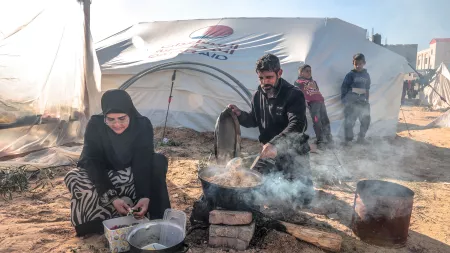The Integrated Food Security and Nutrition Phase Classification (IPC) report released earlier today provides a catastrophic snapshot of food insecurity right now in Gaza and speaks to the urgent need for a ceasefire to allow humanitarian access.
According to the IPC findings, 100% of the population of Gaza – approximately 2.22 million people –are facing levels of hunger crisis due to the ongoing conflict and siege of the enclave. According to the IPC report: “Virtually all households are skipping meals every day.”
“The IPC reveals a dire situation in Gaza, where an alarming 576,600 individuals are currently experiencing catastrophic, famine-levels of starvation,” said Dalmar Ainashe, CARE’s Senior Technical Advisor for Food Security, Livelihoods, and Nutrition, referring to the highest stage of the IPC’s food insecurity classification system, Phase 5. “This figure is unparalleled in the IPC's history, especially when contrasted with Gaza's relatively small population. Prior to this current conflict, the worldwide count of people in IPC Phase 5 was only 128,600. Now, this number is four times higher due to the dangerous conditions in Gaza.”
Tragically, with the death toll surpassing 20,000 people, the situation for civilians there has only worsened since data informing this assessment was collected.
“This is an extreme warning to the international community that there needs to be action today to secure a ceasefire and stop significant and avoidable loss of life in the coming days, weeks and months,” said Aaron Brent, CARE West Bank and Gaza Acting Country Director.
“Humanitarian assistance must be able to reach people safely and consistently before there can be any improvement, but we cannot do so amidst the fighting. We can’t wait for a full famine to break out – by then it’s too late.”
In addition to the fatal risks of starvation, malnutrition, illness, and child wasting caused by extreme hunger, Brent highlighted other dangers posed by Palestinians’ desperate search for food in Gaza: “Innocent families caught up in the fighting will face greater risks of being killed as hunger forces them to seek out limited humanitarian assistance and wait in long lines outside bakeries, further exposing them to the fighting.”
Among those most at risk amid the fighting are women and children who, Brent explained, “are said to account for over 70% of those killed to date.”
Brent also noted that these levels of extreme hunger also dramatically heighten the risk for women and girls of gender-based violence and sexual exploitation and abuse.
He added: “We know from our experience that women and girls usually eat last and least. Severe hunger will have even greater impacts as it negatively affects immune health and exposes them to nutrition-related illnesses, while infectious diseases are spreading rampantly. These levels of extreme hunger also dramatically heighten the risk for women and girls of gender-based violence and sexual exploitation and abuse.”
For media inquiries, please contact Iolanda Jaquemet, Senior Humanitarian Communications Coordinator, CARE International via: [email protected].
